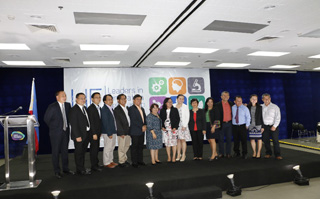 The country’s technology transfer and commercialization efforts are in high spirits having drawn the much needed impetus from the passage of the Technology Transfer Act of 2009.
The country’s technology transfer and commercialization efforts are in high spirits having drawn the much needed impetus from the passage of the Technology Transfer Act of 2009.
Serving as the state’s exemplar to facilitate the flow of government generated technologies from the laboratory to the market, the law has since then inspired numerous initiatives primarily from the state colleges and universities.
The Leaders in Innovation Fellowship (LIF) Programme lends an even stronger support, this time, in moving the technologies with commercial potentials to the market.
A collaboration in science and research innovation between the governments of the United Kingdom (UK) and the Philippines under the Newton Agham Programme, LIF aims to create international networks of innovators, expert mentors, and technology entrepreneurs. It builds the entrepreneurship capacity of researchers to help them commercialize innovations that address development changes.
The LIF Programme is implemented by the UK’s Royal Academy of Engineering (RAEng), Department of Science and Technology (DOST), and AIM.
The Philippine Council for Agriculture, Aquatic and Natural Resources Research and Development (PCAARRD) serves as DOST’s primary implementing and monitoring arm of the LIF program.
On September 7, 2017, fifteen LIF-trained researchers and scientists from the country’s SCUs gathered at the Asian Institute of Management (AIM) to pitch their respective products and technologies.
The activity serves as the final defense and demo of the fellows trained under the LIF Programme.
Comprising the fourth batch of the LIF and their respective products and technologies are:
1. Dr. Prospero C. Naval, Jr., University of the Philippines Diliman (UPD) (Fish-i, a technology that allows rapid reef fish assessment);
2. Dr. Drexcel H. Camacho, De La Salle University (DLSU) (Forti Grains, which offers healthy and nutritious rice incorporating not only minerals but also vitamins);
3. Mr. Arturo M. Ongkeko, Jr., University of the Philippines Mindanao (Community Health Information and Tracking System, which promises to transform health care delivery through quality information);
4. Dr. Chelo S. Pascua of the University of the Philippines Baguio (Modular Potable Water Equipment, which promises to provide clean water anytime and anywhere);
5. Dr. DJ Darwin R. Bandoy, University of the Philippines Los Baños (UPLB) (Novel Anti-Quorum Sensing Feed Additives Antibiotic);
6. Dr. Nilo T. Bugtai, De La Salle University (Semi-Automated Laparascopic Instrument, a revolution towards globally-competitive maneuverable laparascopic devices);
7. Dr. Clarissa Yvonne J. Domingo-Andali, Central Luzon State University (CLSU) (RT LAMP Test Kit, An alternative approach towards early implementation of control and preventive measures against Porcine Epidemic Diarrhea);
8. Dr. Rosula S.J. Reyes, Ateneo de Manila University (Polmonix, a smartphone application for early diagnosis of pediatric pneumonia through digitalized auscultation of the lungs);
9. Dr. Janice A. Ragaza, Ateneo de Manila University (Knowledge Management Office, which provides services as technology movers);
10. Dr. Hidelisa P. Hernandez, UPLB (Fruitect-Natural biocomposite coating to delay ripening of Philippine Carabao Mango);
11. Dr. Ma. Carmen A. Lagman, DLSU (Certification Kits and DIY Tissue-Culture for Philippine Coffee Varieties);
12. Dr. Edgar A. Orden, CLSU (Forage-based Pellets for Goats);
13. Dr. Jonathan N. Nayga, Isabela State University (Chevon Valley, which enhances retailing of chevon);
14. Dr. Mary Donabelle L. Balela, UPD (NANOMETALLink, which offers customized nano-engineered products and services); and
15. Mr. Glen N. Baticados, UPLB, (ACTICon, a biopesticide for Fusarium wilt (Foc TR4 of Cavendish Bananas)
